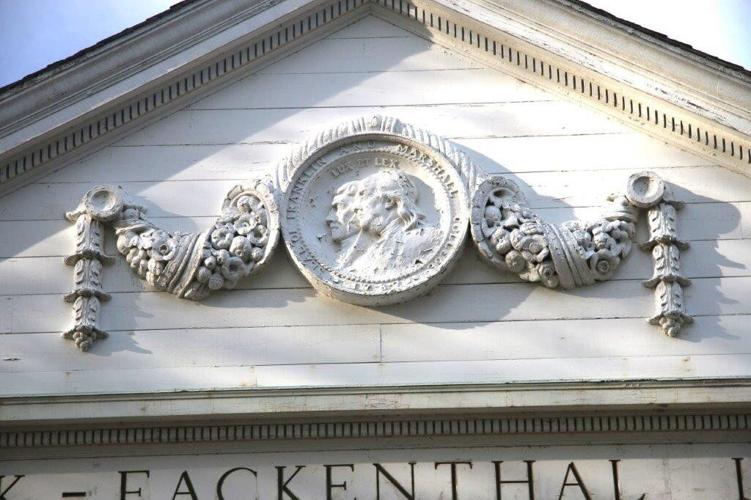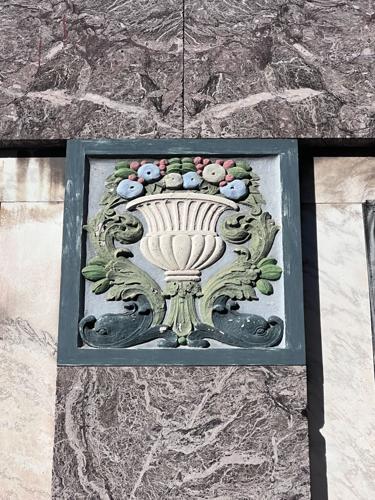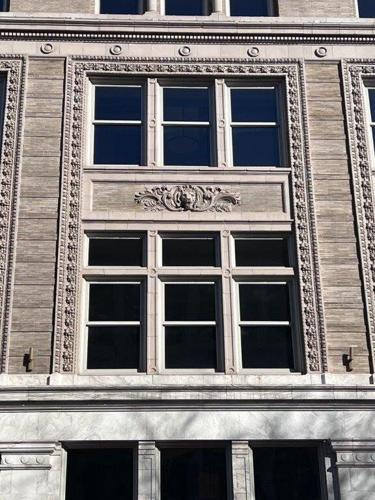ARCHITECTS’ ALPHABET, PART 13: 'M' IS FOR MARGENT
The Architects’ Alphabet is a 26-part series describing design elements featured in Gregory J. Scott’s new book, “Urban Legend, The Life & Legacy of C. Emlen Urban,” Lancaster’s most renowned architect. Photos for the book, which is now available at egganddartbooks. com, are by Matthew Tennison.
There are over 860 words beginning with the letter “m” in the illustrated architects dictionary — and we selected one that is not even listed: margent. Lancaster’s native-son architect, C. Emlen Urban, used margent as a decorative ornament on almost every neoclassical building he designed.
Examples of C. Emlen Urban's margent decorations on Lancaster buildings [photos]
Margent is a vertical arrangement of flowers, fruit, leaves or hanging vines employed purely as a decoration. Architect C. Emlen Urban used it on his public buildings, which you can still see today. Used primarily on civic structures of the 16th, 17th, 18th and 19th centuries, it is found on Beaux Arts, Italian Renaissance, French Renaissance and other romantic styles of the period. Here are some examples of the style around Lancaster.
Simply stated, it is a vertical arrangement of flowers, fruit, leaves or hanging vines employed purely as a decoration. Used primarily on civic structures of the 16th, 17th, 18th and 19th centuries, it is found on Beaux Arts, Italian Renaissance, French Renaissance and other romantic styles of the period.
The 1898 Beaux Arts Watt & Shand building is rich with examples of margent around the windows on the north and west elevations.
Urban used vertical arrangements of cast stone flowers and fruits to serve as a large “picture frame” to bundle the second- and third-floor windows. The flowers and fruits are further framed with bead and reel and egg and dart.
In 1924, Urban introduced beautiful examples of margent on the facade of the Italian Renaissance Griest Building. He framed the tall, two-tiered, flat-relief stone carving of stacked urns containing cornucopia, fruit and flowers.

In 1904, this decorative margent was placed on the Girls High School with festoon, button and vertical drop with fruit.
GREGORY J. SCOTTMargent can also compliment other classical ornamentation such as festoons. The “drops” below the festoon buttons that support the swag are often fruits or flowers, as seen on Urban’s 1904 Stevens Girls School and the 1914 Boys High School. A margent can also frame a cartouche (see letter ‘C’ for cartouche description in the shape of a wreath.) Urban loved classic ornamentation and employed it skillfully on many of his examples of neoclassical civic structures around Lancaster city and neighboring towns.

This building facade in the first block of West King Street, has a margent with an urn, fruit and flowers.
GREGORY J. SCOTTWhat is the etymology of margent?
Margent is an archaic word translating to margin, border or edge.
Were the margents always stone?
Margents were originally carved in wood and painted. Over time, the margents were cast or carved in stone.
Where can an example of a carved wooden margent be found?
The festoon drops on Franklin & Marshall College’s Shadek-Fackenthal Library are painted hand-carved wood.
This column is contributed by Gregory J. Scott, FAIA, a local architect with 50 years of national experience in innovation and design. He is a member of the American Institute of Architects’ College of Fellows. Email GScott@rlps.com.
Success! An email has been sent to with a link to confirm list signup.
Error! There was an error processing your request.





















![7 must-see things at Longwood Gardens this winter, including rare blue poppies [photos, video]](https://bloximages.newyork1.vip.townnews.com/lancasteronline.com/content/tncms/assets/v3/editorial/8/55/8551ad24-c5dd-11ee-a029-cb0a938fc2af/65c3bc6b0778e.image.jpg?resize=150%2C100)
 ERIN NEGLEY | Staff Writer
ERIN NEGLEY | Staff Writer

